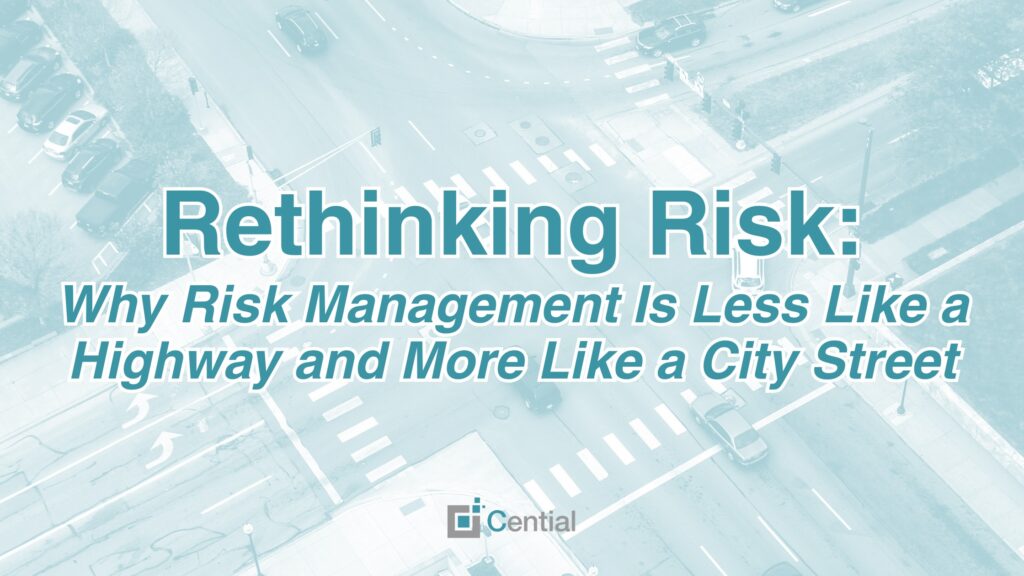
At Cential, we have a saying: “Risk and compliance are the guardrails that help business go faster.”
It is a tidy image. Guardrails prevent disaster and give confidence to move at speed.
But on real roads, guardrails do not run the entire route. They appear at sharp curves, steep drop-offs, and accident-prone zones, where the likelihood and impact of an incident are highest. Most of the time, what keeps traffic moving safely is something less imposing: lane markings, speed signs, and a shared understanding of the rules.
The same principle applies to risk management. Mitigation actions should not be rigid, universal, or over-applied. They should be proportional, purposeful, and tailored to context.
Selecting the Right Mitigation for the Risk
Guardrails are expensive. Sometimes a sign is enough.
Traffic engineers match the intervention to the potential danger: a concrete barrier for a dangerous curve, a yield sign for a low-volume merge, and painted lines to keep cars in lane.
Risk management should follow the same approach. High-risk areas call for stronger controls, ongoing monitoring, frequent testing, and stronger governance. Moderate risk might be managed with fewer controls and periodic monitoring. Lower risks may even need fewer controls, supported by reduced monitoring. This, however, requires a strong risk management program to monitor the residual risk to maintain it at an acceptable level. By aligning the mitigating actions to the risk levels, resources are allocated where they matter most.
Measure Before You Build
Before installing a traffic signal, engineers gather data: vehicle counts, accident history, and near misses.
Risk teams should follow the same sequence. Assess the potential impact, likelihood, and velocity based on historical trends (incidents, issues, exceptions) and the possible future changes. Identify leading indicators of emerging risks and changes to it. Compare the cost of controls with the reduction in residual risk.
It is not only about selecting the proper mitigating actions, but also about shaping the entire risk program. Just as traffic planning considers how every piece of infrastructure fits into the broader flow of a city, risk management requires designing systems, processes, and oversight that work together to keep business moving safely and efficiently.
This discipline ensures programs add value rather than clutter, just as a well-placed signal improves flow while an unnecessary one creates backups.
When Best Practices Backfire
The most effective road systems are not the ones with the most barriers, but the ones where interventions are well-placed, well-designed, and reassessed regularly.
It happens often. A risk program gets built to align with best practices, and neatly documented. Still, it ends up too rigid to use, too costly to maintain, and too disconnected from daily operations.
That is like installing a stoplight at every intersection in a quiet neighborhood. The intent is safety, but the outcome is bottlenecks, delays, and even noncompliance.
Preparing People for the Change
A perfectly engineered traffic system still fails if drivers do not know how to navigate it.
Confusion leads to near misses or outright avoidance of the route.
The same is true of risk programs. Even proportionate, well-designed processes will fail if people do not understand their purpose or how to use them. Successful change management introduces new measures in ways that match organizational readiness, explains the reasons behind them, and provides training and tools for consistent use.
Accounting for Human Factors
Not every driver reacts the same way to the same road. Some take a curve confidently, others slow to a crawl.
Risk teams show the same variation. Cognitive bias and organizational culture influence how risks are perceived and scored. Confirmation bias leads people to see only what they expect. Authority bias means leadership views may outweigh frontline insights.
Good risk management design does not flatten these differences but surfaces them, much like a traffic engineer studying how drivers actually navigate an intersection. Techniques such as independent reviews, diverse assessment panels, and calibrated scoring rubrics help organizations account for these differences.
In Summary
Risk management is not about slowing business down. It is about creating the conditions for confident, informed decisions.
Like traffic planning, context matters. A stop sign in the wrong place confuses. A guardrail where none is needed wastes money. The strongest risk management programs know when to build the guardrail, when to paint the line, and when to simply keep watch on the road ahead.
